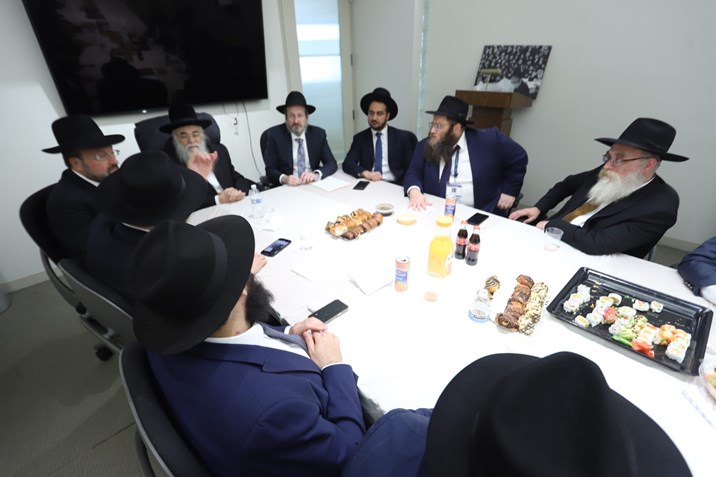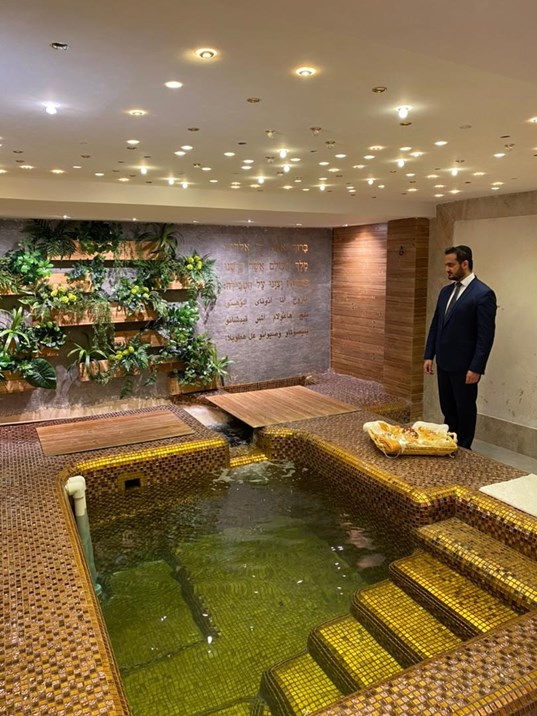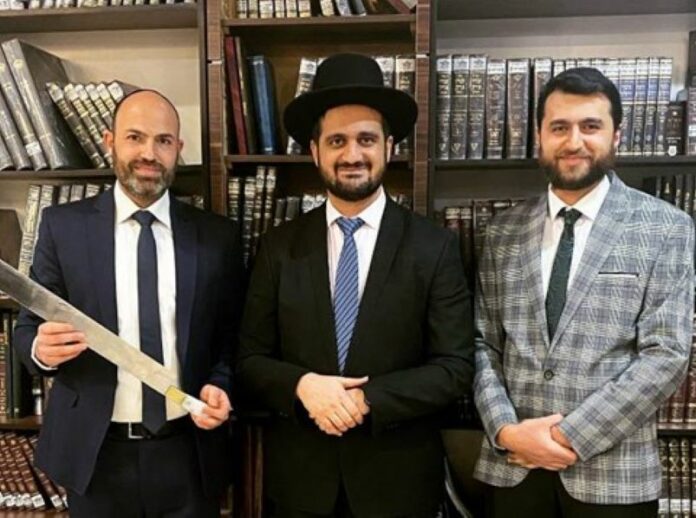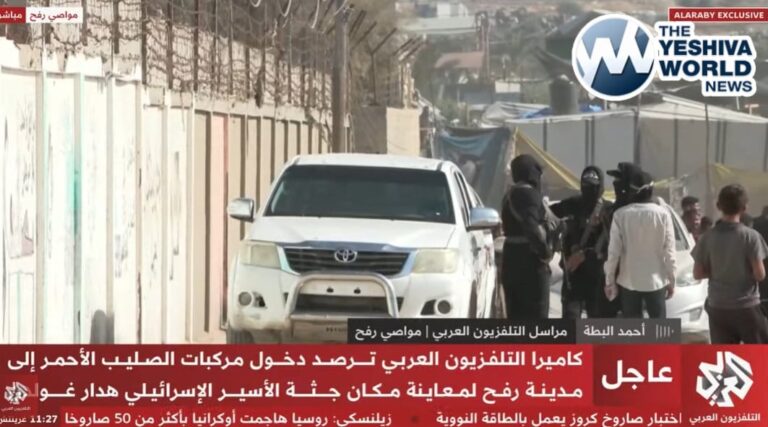HaRav Gerami, who as the Rav of Iran, has to tread carefully, generally avoids talking to the press. However, he made a rare exception during his stay in New York as an honored guest to HaRav Moshe Kotlarsky at the International Conference of Chabad-Lubavitch Shluchim.
In a fascinating interview in the newspaper Merkaz HaInyanim, he shares the challenges facing the Jews of Iran, indulges in nostalgia for his youth at the Yeshivas Ateres Yisrael, and describes his goals for his Jewish kehilla.
HaRav Gerami was born to a warm frum family with ancient roots in Persia. His father, Dr. Shlomo Gerami, z’l, was a surgeon and worked in many medical centers in Tehran, including the Jewish “Sapir” Medical Center, which serves the general Iranian population.

HaRav Gerami could have lived a comfortable life in the US but his sense of responsibility for the Jews in Iran guided him to a different type of life. “My shlichus is wherever I am,” he said. “It was easier for me to be in America, to study in kollel or serve as the Rav on the East Side of Manhattan. I have US citizenship and I could have earned a respectable salary without any headaches. But hashgacha led me to serve as the Rav of the Jews of Iran. Chazal told us: ‘In a place where there are no men, strive to to be a man.’ So I try to do what is necessary.”
“I have a kehilla throughout the country that needs a Rav to tend to all things Jewish – to be mashgiach on kashrus, to supervise the mikvaos – we have mikvaos mehudaros here. That’s my tafkid and it’s a tafkid that influences generations. Like a captain who can’t abandon the ship, if I already accepted this responsibility – I need to fulfill it. It’s true, it would have been much easier to live in a city like Los Angeles or Baltimore and serve as a Rav of a shul for Iranians. My children could have gone to yeshivos, learned in Jewish schools, kashrus is taken care of and there’s a wide selection. But I have a tafkid that I can’t abandon.”

“What’s the situation now in the Jewish kehilla in Iran?”
“Baruch Hashem, nothing has changed. We’re continuing to develop the mosdos. We have a yeshiva now, a kollel. A few months ago, we opened a kollel in Isfahan, a city that has never had a kollel until now. We’re continuing to maintain our hashgachas kashrus on the restuarants, we have talmudei Torah. We added shiurei Torah for the elderly, youth and children. And we maintain shiurei halacha, Gemara, Mishnayos, etc.”

How is your relationship with the authorities in the country?
“Baruch Hashem, excellent. The authorities respect the Jewish religion, there are no restrictions.”
And how do the residents treat you in light of the very tense situation in Iran?
“We are very respected. The situation [the ongoing protests] doesn’t bother us, we never become involved in politics. The Jewish kehilla distances itself from matters that are unrelated to it.”
Is the Jewish kehilla flourishing or declining?
“Baruch Hashem, our rate of growth is only increasing. We have wedding, brisos, etc. almost every week. Most of the Jews in Iran are davka young.”
Are the Jews in Iran seeking a connection to Yiddishkeit?
“Most of the Jews in Iran are shomrei mesoreh. They have great yiras Shamayim. Many of them didn’t have much knowledge about Yiddishkeit because we didn’t have the mosdos that exist today, but they believe in the Torah and the Jewish mesorah.”
What are your challenges in the community?
“As in other places, the looming challenge is the young generation because everything is open and they are exposed to problematic content through the Internet and various forms of media. We need to protect the young generation from all kinds of hashkafos that aren’t in line with Yiddishkeit and deal with the nisyonos of tznius, social media and the like”.
What do you remember from your youth in yeshiva?
“I learned how to learn at Yeshivas Ateres Yisrael. And I learned what Yiras Shamayim is from HaRav Chaim Walkin, z’tl. I was influenced by him from the way he served Hashem, with yiras Shamayim.”
Do you think it’s more difficult to live as a Jew in Iran?
“There are nisyonos in every location. There are places where the nisyonos stem from wealth and in other locations, the nisyonos stem from poverty. Like the Navi says: ‘והנדחים .בארץ מצרים’ Eretz Mitzrayim is referring to people who are in tzara, in straits, and Eretz Ashur is a place of wealth. So it doesn’t matter if a Jew is in Mitzrayim or Ashur, every place has its nisyonos. Our nisyonos are of course different. There are the nisyonos I talked about before – tznius, social media – as well as issues of kefira which unfortunately have been spreading recently. There are other nisyonos in other contexts.”
“The Jews in Iran are like in a closed box They aren’t in contact with world Jewry. This makes matters related to Yiddishkeit a little difficult. But Baruch Hashem and His great chasadim, there are no complaints.”
How is life there in general?
“In general, b’seder gamur. At the same time, the economic situation is difficult in the wake of the sanctions imposed on the country in recent years. Unfortunately, it is becoming more difficult to manage financially.”
How do you see the future of Iranian Jewry? Is it in danger, chalilah?
“There is no danger to the Jews of Iran. The Jews have been living there for already 2,700 years, since the Galus of Ashur. It is written in Sefer Melachim: ‘And the king of Ashur exiled Yisrael to Assyria and he settled them in Halah and in Habor, the Gozan River and the cities of Madai.'”
“These are the cities of Madai and Persia, western Iran. Since the galus of Ashur of the ten shevatim, the Jews live in Iran. There’s been ups and downs, but there were always Jews there.”
What are your main plans for the coming years?
“I mainly focus on chinuch, that’s my main goal. As I said before, we also have kosher restaurants in every city, we have mikvaos, but the main thing that concerns me, beyond maintaining the existing mosdos, is to develop chinuch in the country. My goal is to increase activities for the young and also make sure that the adults have knowledge about Yiddishkeit. In my opinion, it is not enough to have a good heart and yiras Shamayim, our kehilla needs more Torah knowledge. When I was young, there were almost no Gemara shiurim. I would use Hebrew-Aramaic and Hebrew-Persian dictionaries and I would learn alone, at the age of 11-12.”
“Nowadays, baruch Hashem, children here already start learning Mishnayos at the age of 7-8 there are many children who study Gemara. This is something that never existed in the past. The Jews in Iran feel a connection with world Jewry but they don’t like politics, they stay away from it. But every Jew, wherever he is is a Jew, no matter where he is, America, Europe or Iran, is Jewish and believes in the same principles.”
“We live in a generation in which we see the chevlei Moshiach and hear his footsteps. We all need to do teshuvah, to draw closer to Hakadosh Baruch Hu. And also to be mekareiv the people who are distant.”
(YWN Israel Desk – Jerusalem)












3 Responses
Chazak uBaruch
I am reminded of R Moshe Rosen z”l, the chief rabbi of Romania under Ceausescu y”sh, and how he would travel the world telling everyone how wonderful the government was to the Jews, and everyone understood that he meant the opposite. As the fellow said, “Can’t complain”.
The Iranians are much more respectful of Judaism than the Soviets ever were.